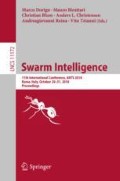Abstract
Systems showing collective motion are partially described by a distribution of positions and a distribution of velocities. While models of collective motion often focus on system features governed mostly by velocity distributions, the model presented in this paper also incorporates features influenced by positional distributions. A significant feature, the size of the largest connected component of the graph induced by the particle positions and their perception range, is identified using a 1-d self-propelled particle model (SPP). Based on largest connected components, properties of the system dynamics are found that are time-invariant. A simplified macroscopic model can be defined based on this time-invariance, which may allow for simple, concise, and precise predictions of systems showing collective motion.
Access this chapter
Tax calculation will be finalised at checkout
Purchases are for personal use only
References
Chazelle, B.: An algorithmic approach to collective behavior. J. Stat. Phys. 158(3), 514–548 (2015)
Czirók, A., Barabási, A.L., Vicsek, T.: Collective motion of self-propelled particles: kinetic phase transition in one dimension. Phys. Rev. Lett. 82(1), 209–212 (1999)
Czirók, A., Vicsek, T.: Collective behavior of interacting self-propelled particles. Physica A 281, 17–29 (2000)
Degond, P., Yang, T.: Diffusion in a continuum model of self-propelled particles with alignment interaction. Math. Models Methods Appl. Sci. 20, 1459–1490 (2010)
Hamann, H.: Space-Time Continuous Models of Swarm Robotics Systems: Supporting Global-to-Local Programming. Springer, Berlin (2010). https://doi.org/10.1007/978-3-642-13377-0
Hamann, H.: Towards swarm calculus: universal properties of swarm performance and collective decisions. In: Dorigo, M., Birattari, M., Blum, C., Christensen, A.L., Engelbrecht, A.P., Groß, R., Stützle, T. (eds.) ANTS 2012. LNCS, vol. 7461, pp. 168–179. Springer, Heidelberg (2012). https://doi.org/10.1007/978-3-642-32650-9_15
Hamann, H.: Towards swarm calculus: urn models of collective decisions and universal properties of swarm performance. Swarm Intell. 7(2–3), 145–172 (2013). https://doi.org/10.1007/s11721-013-0080-0
Hamann, H.: Swarm Robotics: A Formal Approach. Springer, Cham (2018). https://doi.org/10.1007/978-3-319-74528-2
Hamann, H., Meyer, B., Schmickl, T., Crailsheim, K.: A model of symmetry breaking in collective decision-making. In: Doncieux, S., Girard, B., Guillot, A., Hallam, J., Meyer, J.-A., Mouret, J.-B. (eds.) SAB 2010. LNCS (LNAI), vol. 6226, pp. 639–648. Springer, Heidelberg (2010). https://doi.org/10.1007/978-3-642-15193-4_60
Hamann, H., Valentini, G.: Swarm in a fly bottle: feedback-based analysis of self-organizing temporary lock-ins. In: Dorigo, M., Birattari, M., Garnier, S., Hamann, H., Montes de Oca, M., Solnon, C., Stützle, T. (eds.) ANTS 2014. LNCS, vol. 8667, pp. 170–181. Springer, Cham (2014). https://doi.org/10.1007/978-3-319-09952-1_15
Hamann, H., Wörn, H.: A framework of space-time continuous models for algorithm design in swarm robotics. Swarm Intell. 2(2–4), 209–239 (2008). https://doi.org/10.1007/s11721-008-0015-3
Helbing, D., Schweitzer, F., Keltsch, J., Molnár, P.: Active walker model for the formation of human and animal trail systems. Physical Review E 56(3), 2527–2539 (1997)
Hillen, T., Painter, K.J.: A user’s guide to PDE models for chemotaxis. Math. Biol. 58, 183–217 (2009). https://doi.org/10.1007/s00285-008-0201-3
Khaluf, Y., Pinciroli, C., Valentini, G., Hamann, H.: The impact of agent density on scalability in collective systems: noise-induced versus majority-based bistability. Swarm Intell. 11(2), 155–179 (2017). https://doi.org/10.1007/s11721-017-0137-6
Levine, H., Rappel, W.J., Cohen, I.: Self-organization in systems of self-propelled particles. Phys. Rev. E 63(1), 17101 (2000)
Milutinovic, D., Lima, P.: Cells and Robots: Modeling and Control of Large-Size Agent Populations. Springer, Berlin (2007). https://doi.org/10.1007/978-3-540-71982-3
Okubo, A.: Dynamical aspects of animal grouping: swarms, schools, flocks, and herds. Adv. Biophys. 22, 1–94 (1986)
Prorok, A., Correll, N., Martinoli, A.: Multi-level spatial models for swarm-robotic systems. Int. J. Robot. Res. 30(5), 574–589 (2011)
Reina, A., Marshall, J.A.R., Trianni, V., Bose, T.: Model of the best-of-\(n\) nest-site selection process in honeybees. Phys. Rev. E: 95, 052411 (2017). https://doi.org/10.1103/PhysRevE.95.052411
Reina, A., Valentini, G., Fernández-Oto, C., Dorigo, M., Trianni, V.: A design pattern for decentralised decision making. PLOS ONE 10(10), 1–18 (2015). https://doi.org/10.1371/journal.pone.0140950
Schimansky-Geier, L., Mieth, M., Rosé, H., Malchow, H.: Structure formation by active Brownian particles. Phys. Lett. A 207, 140–146 (1995)
Schweitzer, F.: Brownian Agents and Active Particles: On the Emergence of Complex Behavior in the Natural and Social Sciences. Springer, Berlin (2003)
Valentini, G., Hamann, H.: Time-variant feedback processes in collective decision-making systems: influence and effect of dynamic neighborhood sizes. Swarm Intelligence 9(2–3), 153–176 (2015). https://doi.org/10.1007/s11721-015-0108-8
Vicsek, T., Czirók, A., Ben-Jacob, E., Cohen, I., Shochet, O.: Novel type of phase transition in a system of self-driven particles. Phys. Rev. Lett. 6(75), 1226–1229 (1995)
Vicsek, T., Zafeiris, A.: Collective motion. Phys. Rep. 517(3–4), 71–140 (2012)
Yates, C.A., et al.: Inherent noise can facilitate coherence in collective swarm motion. Proc. Natl. Acad. Sci. USA 106(14), 5464–5469 (2009). https://doi.org/10.1073/pnas.0811195106. http://www.pnas.org/content/106/14/5464.abstract
Author information
Authors and Affiliations
Corresponding author
Editor information
Editors and Affiliations
Rights and permissions
Copyright information
© 2018 Springer Nature Switzerland AG
About this paper
Cite this paper
Hamann, H. (2018). The Role of Largest Connected Components in Collective Motion. In: Dorigo, M., Birattari, M., Blum, C., Christensen, A., Reina, A., Trianni, V. (eds) Swarm Intelligence. ANTS 2018. Lecture Notes in Computer Science(), vol 11172. Springer, Cham. https://doi.org/10.1007/978-3-030-00533-7_23
Download citation
DOI: https://doi.org/10.1007/978-3-030-00533-7_23
Published:
Publisher Name: Springer, Cham
Print ISBN: 978-3-030-00532-0
Online ISBN: 978-3-030-00533-7
eBook Packages: Computer ScienceComputer Science (R0)

